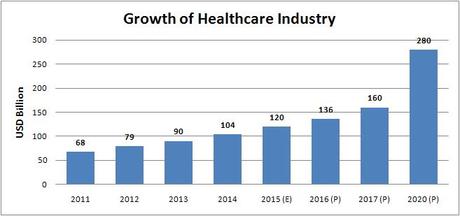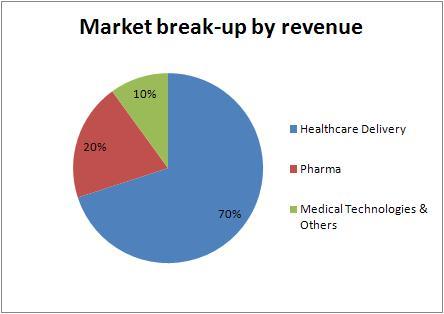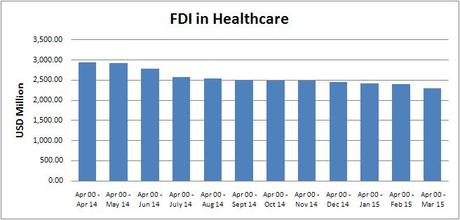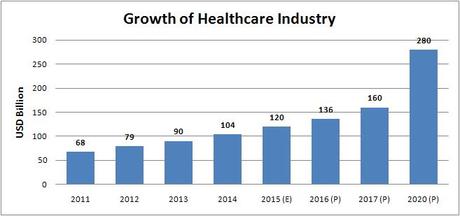The Indian healthcare sector consists of Healthcare delivery, Pharmaceuticals, Medical technologies and others. Within the industry, Healthcare delivery is the largest segment contributing 70% of the industry revenue followed by Pharmaceutical at 20% of the total revenue and Medical technologies and others contributing 10%. The Hospital segment is highly fragmented with 90% of the hospitals being established and operated by doctors & trusts and the balance are being managed by corporate hospitals chains (Apollo Hospital, Fortis Healthcare, etc). While the public sector was the predominant service provider for most of the post-Independence era, over the last two decades the private sector in India has steadily grown and enhanced its quality of operations to emerge as the leading provider of the entire array of healthcare services. The private sector provides majority of secondary, tertiary and quaternary care institutions with a major concentration in metros, tier II and tier I cities. Large investments by private sector players are likely to contribute significantly to the development of India’s hospital industry and the sector is poised to grow to $120 billion by the year 2015 and further to $280 billion by 2020. Private sector’s share in healthcare delivery is expected to increase to 81% by FY 2015. Private sector’s share in hospitals and hospital beds is estimated at 74% and 40%, respectively.

India’s healthcare matrix Indian healthcare sector is witnessing exceptional pressure to provide quality measures to millions of its citizens because of issues related to access and affordability. This is compounded as a result of shortages of workforce and infrastructure. India has a ratio of 0.65 doctors, 1 nurse and 0.9 beds per 1,000 people. The projected density of doctors, nurses and beds clearly connotes a large demand-supply gap in the Indian health care industry, thus providing a huge untapped potential for healthcare providers.
In comparison with other countries, India is lagging behind China and Brazil on many key healthcare parameters. China has 3.9 hospital beds every 1,000 people, whereas Singapore has 2.7. The figures are even more alarming for nurses, while in the United States there are 9.82 nurses per 1,000 people and in India there is only 1. In order to meet the global median of 30 beds per 10,000 population, India will need to invest over Rs 14 trillion ($230 billion). Medical tourism a burgeoning industry in India India is competitive in healthcare costs as compared to the developed countries and other nations in Asia. It offers the same standards and quality care at a substantially lower cost. India has the most number of US FDA approved drug manufacturing units and its healthcare system is based on western medicine (predominantly). The country also offers a large number of wellness tourism options like yoga, ayurveda, naturopathy, acupuncture, spa/massages, etc. However, the country needs to work on increasing efficiency at the immigration to make the traveling experience hassle free for patients and also better infrastructure in terms of highways and roads would add to the overall satisfaction of medical tourists.

The medical tourism market in India is projected to hit $3.9 billion mark this year having grown at a compounded annual growth rate of 27 per cent over the last three years. The inflow of medical tourists is expected to cross 320 million by 2015. The medical tourism industry in India gets maximum patients for heart surgery, knee transplant, cosmetic surgery and dental care as the cost of treatment in India is considered to be the lowest in Asia, much lower than Thailand, Indonesia, Singapore and Hong Kong. Investments in sector The hospital and diagnostic centres attracted foreign direct investment (FDI) worth $3,074.01 million or Rs 16,313.98 crore between April 2000 and March 2015, according to data released by the Department of Industrial Policy and Promotion (DIPP). Recent developments in the Healthcare Industry India and USA sign agreements to strengthen cooperation in health sector India and the United States of America (USA) signed Memorandums of Understanding (MoUs) on Cooperation on Cancer Research, Prevention, Control and Management and Collaboration in Environmental and Occupational Health and Injury Prevention and Control, and a Letter of Intent (LoI) on Antimicrobial Resistance Research. The MoU for cooperation on cancer research prevention, control and management was signed between the National Cancer Research Institute of the All India Institute of Medical Sciences, the Indian Council of Medical Research (ICMR), Department of Health Research, Ministry of Health and Family Welfare, the Department of Biotechnology, Ministry of Science and Technology and National Cancer Institute of the National Institute of Health and Department of Health and Human Services (DHHS), USA. India, Mauritius ink MoU on cooperation in traditional systems of medicine and homoeopathy The Union Cabinet gave its approval for the Memorandum of Understanding (MoU) on Cooperation in Traditional Systems of Medicine and Homoeopathy between India and Mauritius. The MoU will enhance bilateral cooperation between the two countries in the areas of traditional medicine including medicinal plants. This will be of immense importance to both countries, considering their shared cultural heritage. Both India and Mauritius share several cultural, historical, linguistic and literary similarities. Traditional medicine including medicinal plants are promising areas which need to be further explored and can prove to be mutually beneficial to the people of the two countries. The financial resources necessary to conduct research, training courses, conferences/ meetings and deputations of experts will be met from the existing allocated budget and existing plan schemes of the Ministry of AYUSH. Govt sets up Board to boost medical tourism In a bid to boost medical tourism, the government of India has set up National Medical and Wellness Tourism Board to provide help to those visiting the country for health care need. The Board, besides Ministry officials, will include other stakeholders such as hospitals, hoteliers, medical experts and tour operators. India is an affordable destination for people looking for best medical care at cost much lower than that of developed countries. This would also give a boost to alternative treatment such as yoga, ayurveda and unani.

- Sanofi-Synthelabo (India) had invested Rs 90 crore ($14.47 million) in Apollo Sugar Clinics (ASCL), a unit of its subsidiary Apollo Health and Lifestyle.
- Apollo Hospitals Enterprise (AHEL) plans to add another 2,000 beds over the next two financial years, at a cost of around Rs 1,500 crore ($241.24 million).
- Temasek Holdings Pte has acquired the entire 17.74 per cent stake of Punj Lloyd in Global Health Pvt, which owns and operates the Medanta super specialty hospital in Gurgaon, Haryana.
- Apollo Health and Lifestyle (AHLL), a wholly-owned subsidiary of Apollo Hospitals Enterprise, has acquired Nova Specialty Hospitals at an estimated cost of Rs 135-145 crore ($21.71-22.32 million).
- CDC, the UK’s development finance institution, has invested $48 million in Narayana Hrudayalaya hospitals, a multi-speciality healthcare provider. With this investment, Narayana Health will expand affordable treatment in eastern, central and western India.

- See more at: http://money.livemint.com/news/sector/outlook/vast-opportunities-in-medical-tourism-to-help-healthcare-sector-in-coming-time-384361.aspx#sthash.9QYuwa0o.dpuf
